If you buy through our links, we may earn an affiliate commission. This supports our mission to get more people active and outside.Learn about Outside Online's affiliate link policy
Ask A Gear Guru: What Are the Best Trail Shoes For Spring 2020?
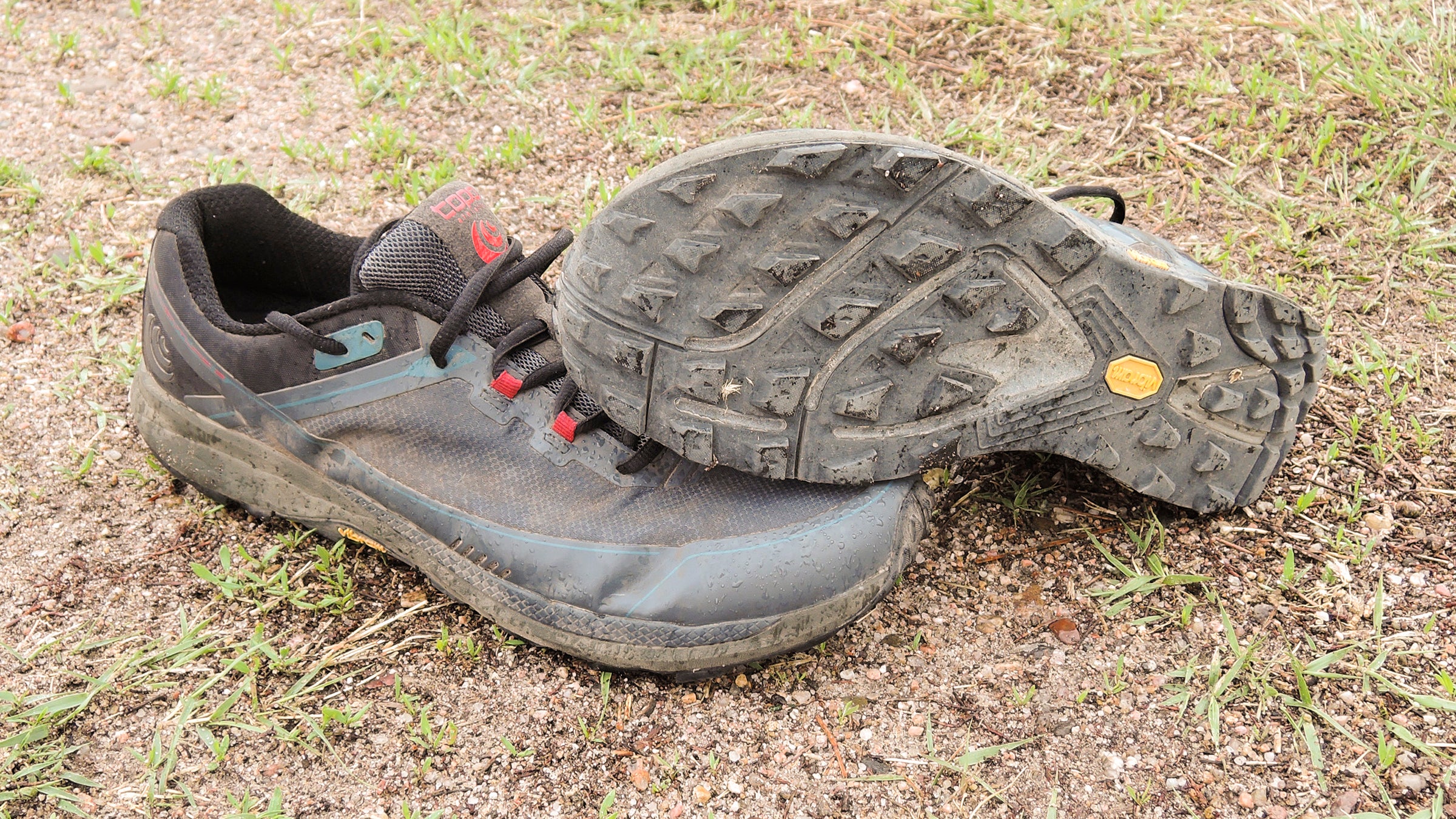
(Photo: 101 Degrees West)
If your area has already lifted restrictions on exercising outside around popular areas like paved bike paths, beaches, and parks, you’re probably already aware of the throngs of new runners and bikers who have a newfound appreciation for the outdoors. But rather than serve as an unwilling member of their training obstacle course while they grapple with social distancing, ill-fitting face coverings, and simply understanding how their bodies move, now’s a great time to hit the trails. Assuming you can safely keep your distance and follow your area’s guidelines (no closed trails, guys!), the best place you can be running is definitely off road. The good news is that this spring has a host of amazing new trail shoes that’ll not only help you when you’re flying over the dirt, but also on the road to get there. We’ve tapped trail running expert and editor-in-chief of Podium Runner to get the lowdown on the best trail running shoes this spring. But first, we have a few tips on what to look for when trying to find the pair that works best for you.
Different Horses For Different Courses
Even more than when choosing a pair of running shoes for the road, the best pair of trail running shoes this spring for you will be the pair that matches and complements the type of terrain you’ll be running on. While it’s very unlikely that you’ll need something as ridiculously specialized as Hoka’s crazy downhill running shoes, the TenNine, it’s still important to be realistic about the surfaces and incline severity you’re usually on. If you’re in an area that gets a lot of rain—and the trails don’t drain that well—think about a pair with bigger lugs for better grip and mud shedding. If you’re on super rocky trails with sharp rocks jutting out of the ground, be sure to get something that offers you proper protection. If you’re in a super hilly area, don’t forget that what comes up, must come down, so you’ll want a pair that provides a level of cushioning you’re comfortable with on the descents. One final warning on conditions: If you live in an area where you’ll be running in the heat of the summer, do NOT get anything with Gore-Tex (sometimes “GTX”), as your feet will become swamps in no time.
Maximalist/Minimalist?
Similar to your choices for road running, trail shoes today offer a range of support for different types of running styles and preferences. Like we mentioned above, those who prefer to feel the terrain underneath and want something that’ll keep them nimble over tricky sections, there are a host of minimalist options even from brands that used to only make one single trail shoe model. On the other hand, if you’re running on super dense, hard packed trails with lots of up and downhill—or you simply like more cushioning for longer off-road runs—there are also a few maximalist options available. Also of note: Though not always the case, a good rule of thumb for trail running shoe brands is if the company has a background in running (Saucony, New Balance, Asics, etc.), it’s likely that their midsole is a bit cushier/supportive/substantial. If the brand has a background in hiking/outdoors (Merrill, Arc’Teryx, etc.), the upper is often incredibly built, while the midsole and cushioning is often more minimal/simple.
Be Realistic
If you think you’ll be spending over 50% of your running on trails, a trail shoe is a great way to go; less than that, and you may also need a pair of road runners. It’s not the worst thing in the world to alternate pairs of running shoes daily—studies have found that using a variety of vastly different running shoes can actually prevent overuse injuries. That said, if you’re going to be spending a good amount of mileage simply getting to the trailhead before you begin your offroad run, be sure to take that into account as well. That minimalist pair of trail shoes that works great in the grass and dirt may not feel so good on the hard, paved roads (though for some, it might!). Just stick to the maxim, “know thyself.”
Without further ado, below is our list of the best trail shoes for trail running this spring, as tested by Podium editor-in-chief, Jonathan Beverly:
Best Trail Shoes For Spring 2020: On Cloudventure Peak
Weight: 9.2 oz (M); 7.4 oz (W)
Drop: ~4mm
Price: $150
On-running.com
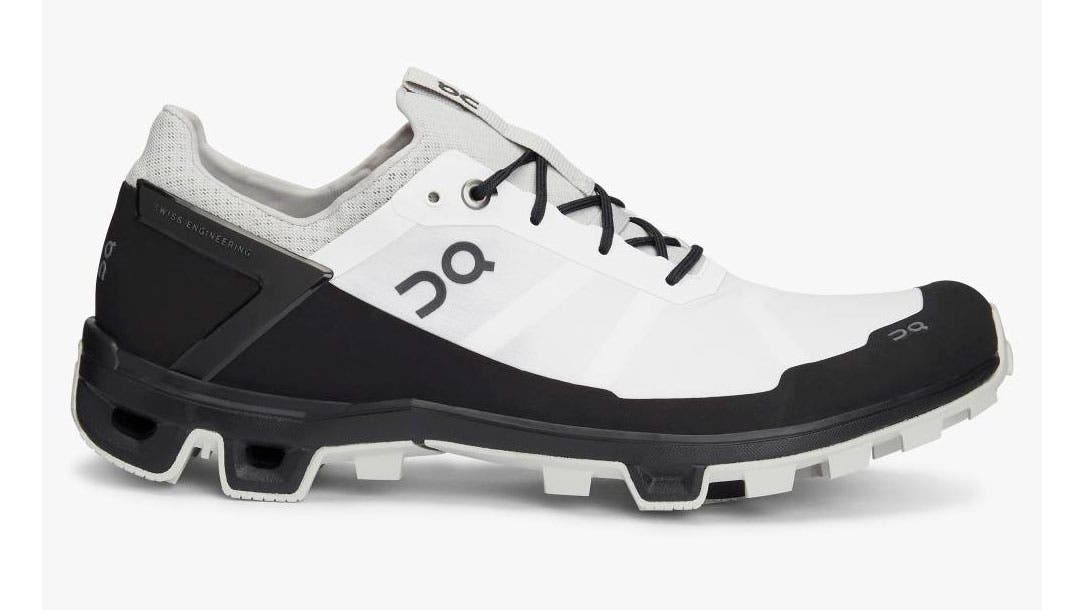
The Cloudventure Peak is On’s second generation of trail shoe, and they made some solid improvements while retaining the exceptional fit and ride. To start, the designers gave the sole a radical makeover. On’s original thin, rubber “clouds”—the outsole cushioning pods that compress then bottom out for push off—have been traded for square EVA pods that provide responsive cushioning under the ball and heel while doubling as aggressive traction lugs. Multiple sticky-rubber lugs covering the perimeter and toe further enhance the shoe’s traction.
Hidden in the midsole is On’s flexible “Speedboard” that distributes forces and provides a pop to your stride. In the Peak, the speedboard is split in the forefoot and narrow-waisted, both improving adaptability over technical trail surfaces. Testers said the ride felt fast and agile, while surprisingly supportive and confidence-inspiring, particularly on softer trails. The tread gripped well on all but slick surfaces, where the lack of surface area allowed some slippage.
As much as they liked the sole, the upper got the biggest raves. An inner, soft-mesh booty surrounds the foot, while, on the outside, a stretchy, rip-stop layer protects and strategic elastic taping secures without interfering with foot movement.
Best Trail Shoes For Spring 2020: Skechers GOrun Speed TRL Hyper
Weight: 8 oz (unisex)
Drop: ~8mm
Price: $135
Roadrunnersports.com
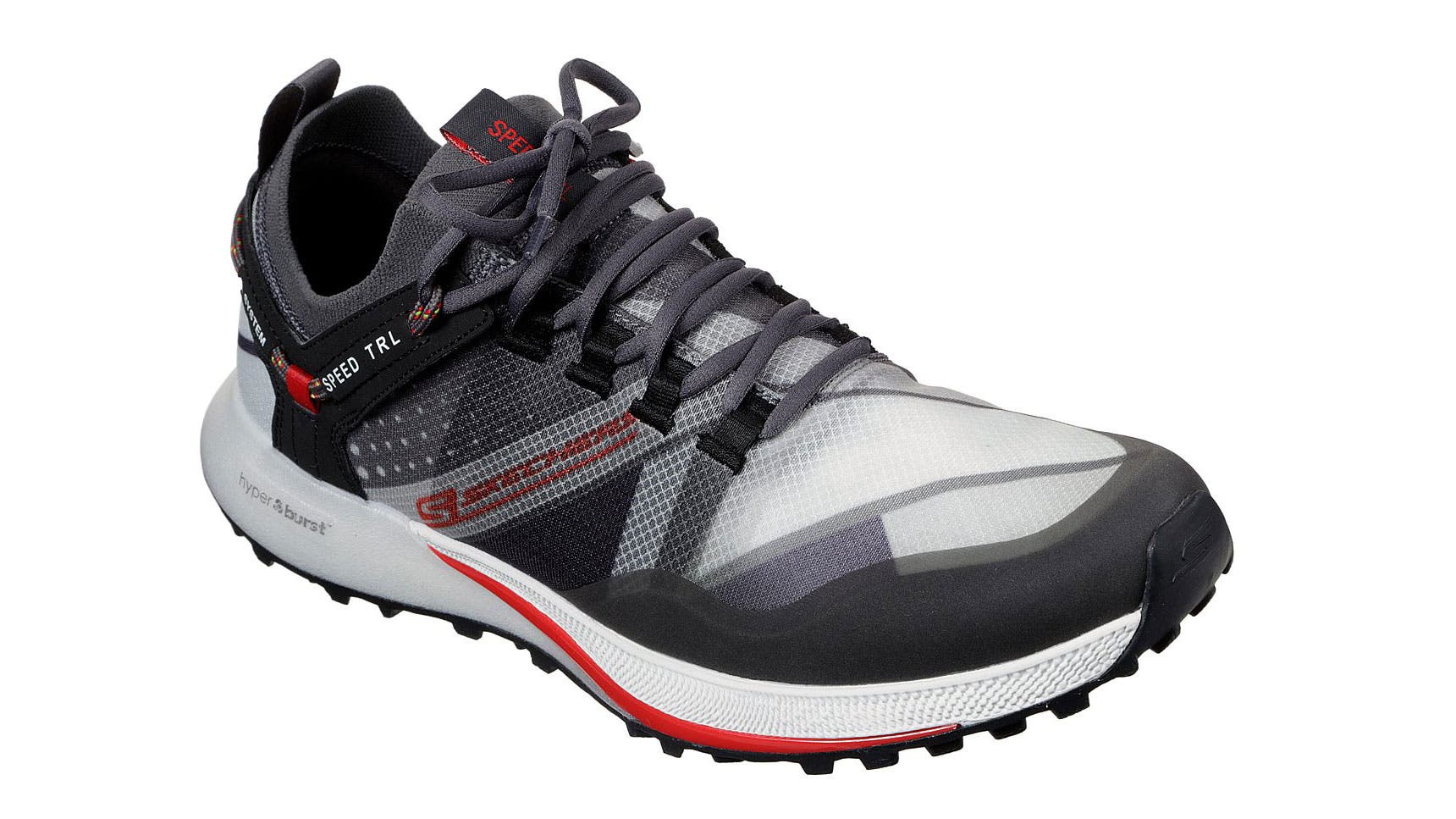
Skechers continues to impress with their performance shoe designs, despite the brand’s reputation as primarily a casual-shoe maker. Even with high expectations, however, the GOrun Speed TRL Hyper doesn’t disappoint. One of the lightest trail shoes on the market, it doesn’t skimp on cushioning—with Skechers’ bouncy Hyperburst foam in the heel—nor on protection—with a curved nylon plate in the forefoot that triples as a penetration-preventing rock plate, a stability platform, and a flexible, bounce-back propulsion plate. What you feel underfoot is a light, quick-rolling ride with thin-but-effective protection that floats over the trail.
The upper fabric is a thin, flexible, but non-stretchy monomesh that is highly breathable and doesn’t absorb water. A burrito tongue wraps over the foot from the arch side, tying down over the instep to hold securely with help from a suede-like internal liner. The heel is held snugly in place with strategic foam pads, a knitted collar and an external heel-lock lacing system. The resulting fit is secure and speedy, anchoring you to the sole and the ground while providing a flexible, rather roomy forefoot. The only complaint was that the shoe’s shape pushed their big toe into the side of the toe cap, creating some irritation, but otherwise, this is one of the favorites of the bunch.
Best Trail Shoes For Spring 2020: Altra Timp 2.0
Weight: 9.9 oz (M); 8.7 oz (W)
Drop: 0 mm
Price: $140
Rei.com
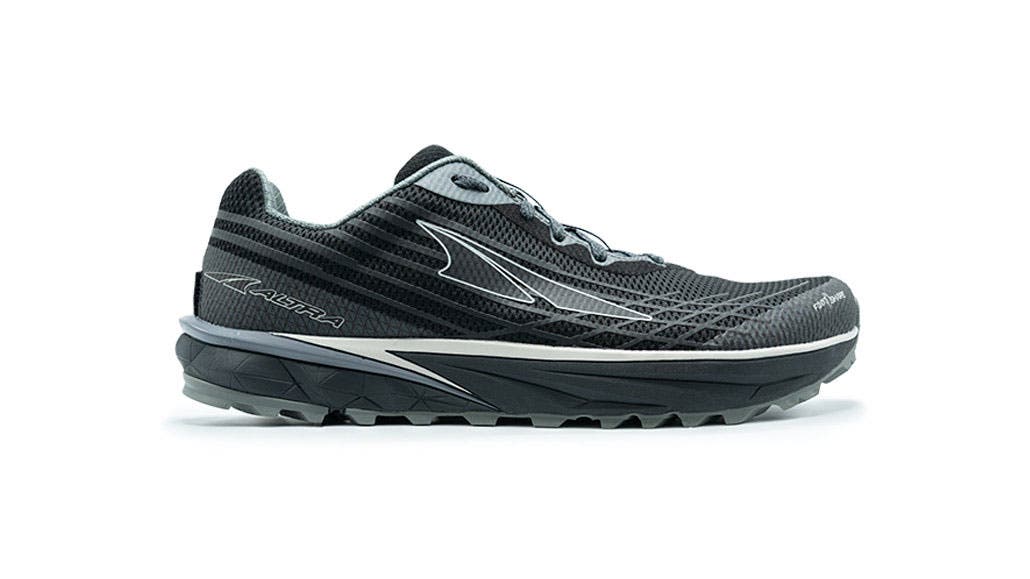
The first Timp—and the version 1.5—delivered an adaptable, well-cushioned ride, but it felt a bit slow and clunky. No more. This second version of the Timp is softer, lighter, more flexible, bouncier and smoother. The outsole is slightly less sluggish (but still plenty grippy), with multiple flex grooves that allow it to move with the foot and flex naturally through the stride. Combined with 29mm of bouncy Quantic midsole, the feel underfoot somehow delivers both plush comfort and responsive performance that allowed our test team to feel the ground underfoot but not worry about bone bruising.
The streamlined mesh upper with flexible overlays completes the package with an excellent fit and roomy toe box. The level cushioning from heel to toe creates stable and nimble footplants over any terrain, while the softness of the midsole adapts the underfoot feel for any stride. We found this shoe kept with the spirit of Altra’s minimalist ethos but with tougher materials for varied weather and terrain.
Best Trail Shoes For Spring 2020: Salomon Sense Ride 3
Weight: 9.9 oz (M); 8.3 oz (W)
Drop: 8 mm
Price: $130
Rei.com
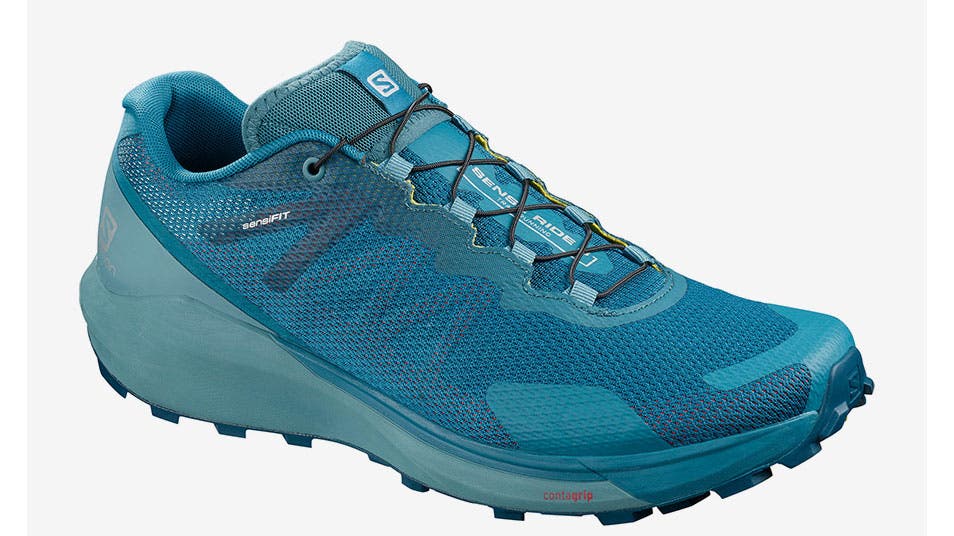
While the original was too narrow and too firm for most runners, this version gets the fit and comfort just right, from step-in to mountain top. With its wider toe box and supportive heel wrap, the upper hugs the foot with an enveloping wrap that we found enhanced the shoe’s sense of agility and responsiveness. Salomon simplified the upper with a clean design using a durable mesh and welded overlays. An internal chassis provides an excellent midfoot hold that is firm yet not binding, and the speedlacing provides Salomon’s signature one-pull, dynamic, secure and adaptable fit. Note that, even with the wider toe box, the upper is a trim fit without a lot of space for those who want or need toe splay roominess (like in the Altra).
The dual-layer midsole with a segmented rock plate does an admirable job of protecting the foot, dampening impact and providing energy return. The ride is appropriately firm and proprioceptive when navigating technical footing, but noticeably softens and smooths landings, particularly on descents—equally soft on landings and firm on push off.
Best Trail Shoes For Spring 2020: Topo RunVenture 3
Weight: 9.5 oz (M); 7.6 oz (W)
Drop: 0 mm
Price: $120
Backcountry.com
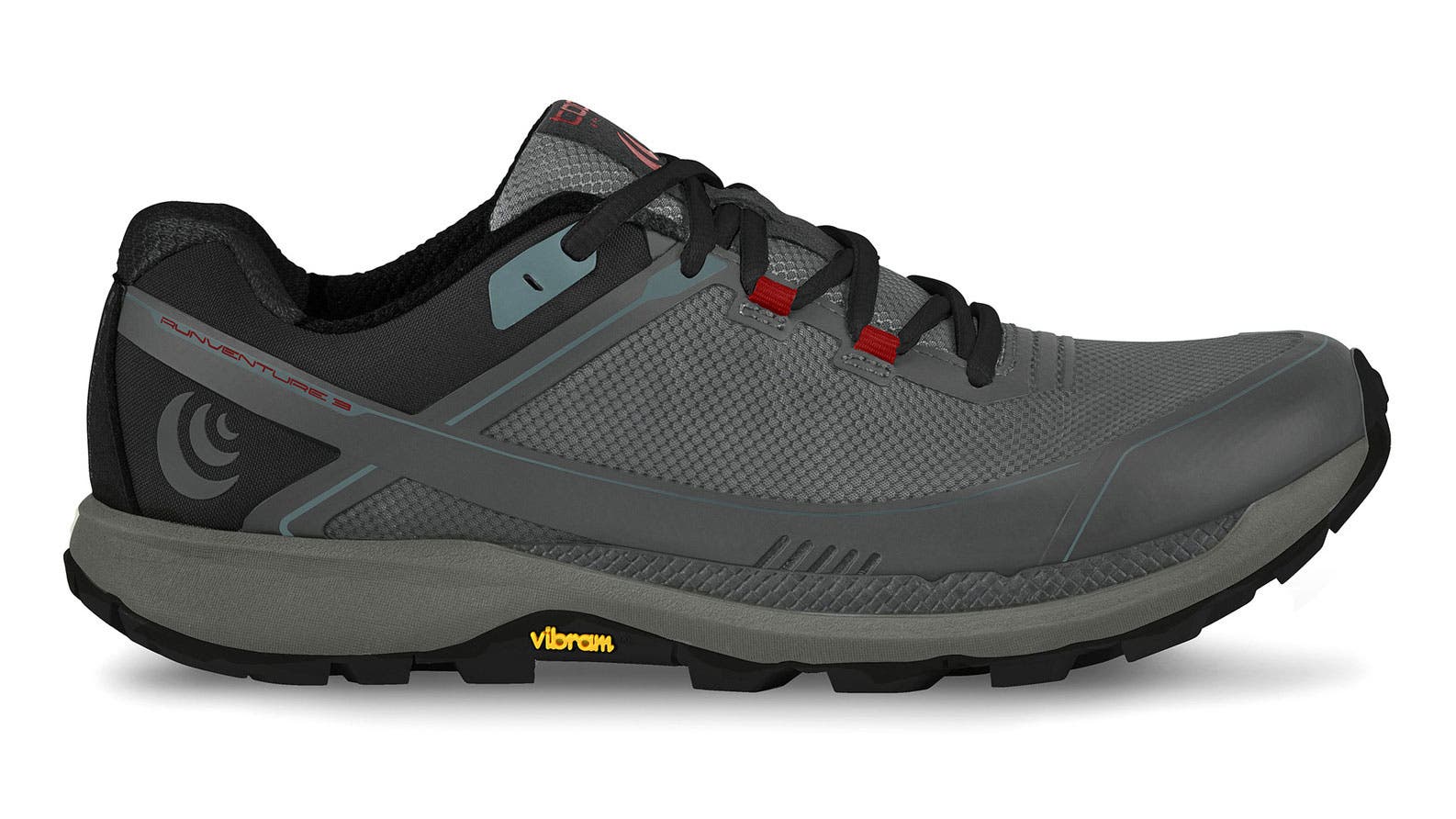
This shoe is all about fit, which secures the heel and midfoot while opening up around the toes: We loved how one’s foot could truly spread out and “relax.” The great fit, flexible sole and zero-drop geometry let your feet work naturally and create a nimble, stable ride with a soft, smooth landing and connected push-offs.
Despite its light weight, the Runventure 3 sports a nearly-full-coverage, durable Vibram rubber outsole and a forefoot rockplate, letting you tackle the toughest trails with confidence. New in this version is the well-padded heel collar and more rigid heel counter for rear-foot security and stability. We did have some issues with tightening the upper and bunching up in the upper’s overlay, but it wasn’t enough to dampen our enthusiasm for these trail runners.
Best Trail Shoes For Spring 2020: HOKA Torrent 2
Weight: 9.3 oz (M); 7.6 oz (W)
Drop: 5 mm
Price: $120 (available June 1)
Hokaoneone.com
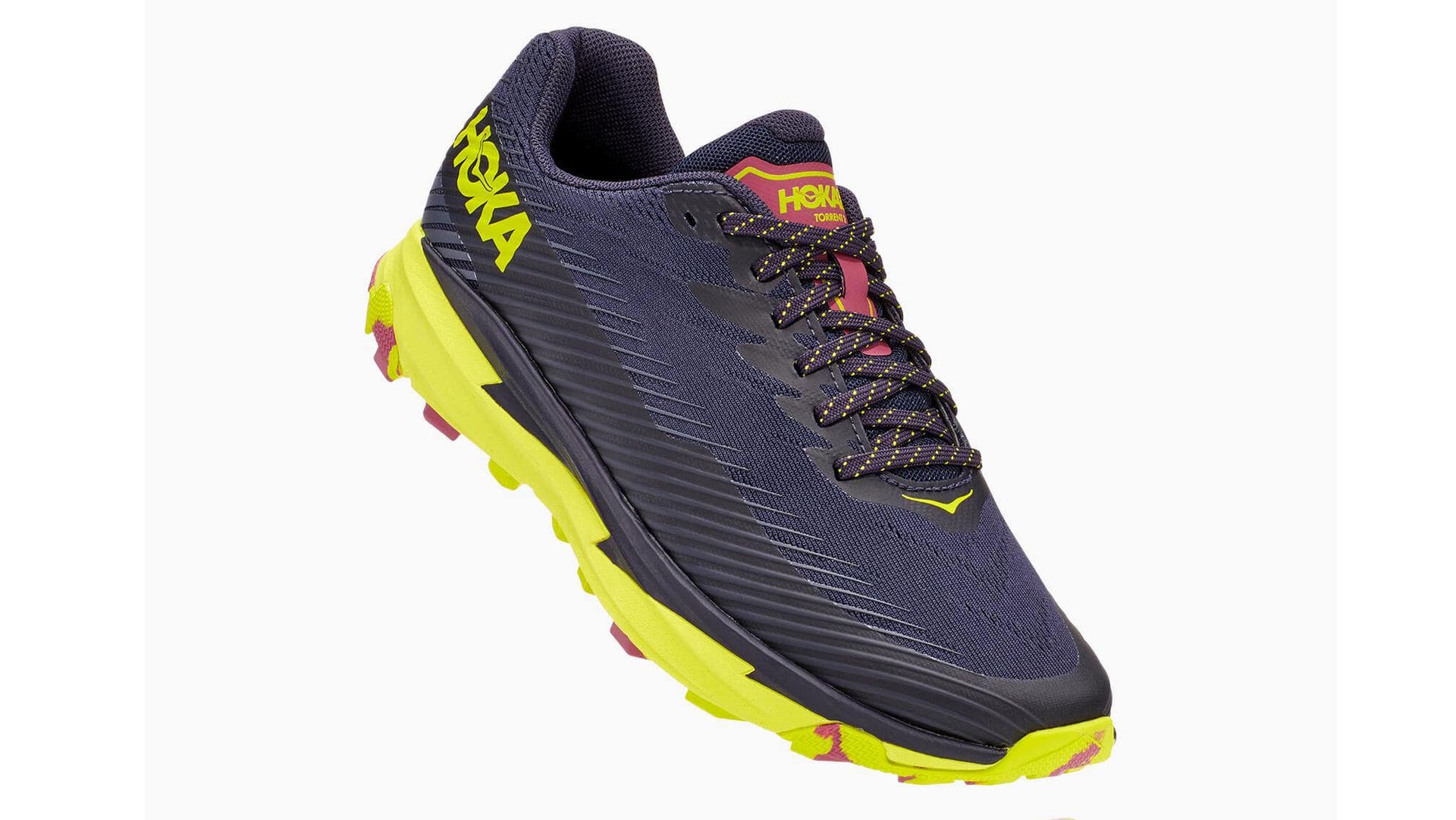
The Torrent 2 is a HOKA trail shoe for people who don’t like HOKAs—although those who do like HOKAs might appreciate them too. A surprisingly responsive shoe from a brand known for high, squishy models, the Torrent 2 flits over trails. The relatively low midsole (23mm heel/18mm toe) provides just enough cushioning to dampen foot strike and smooth over hard things underfoot while connecting to the trail with a firmer forefoot that produces proprioceptive stability and powerful push-offs.
We loved the fit of the updated upper, which has ample width in the forefoot (another HOKA surprise) while providing strong heel and midfoot lockdown. Also an increase in space for the toe box really gave our feet room to rest without moving around and an improved flexible outsole did an amazing job of gripping and not slipping. If you’re looking for a “light with grip” shoe that delivers a smooth HOKA ride but not the HOKA squish, the Torrent 2 is worth a try.